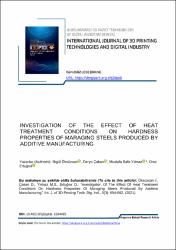Investigation of the Effect of Heat Treatment Conditions on Hardness Properties of Maraging Steels Produced by Additive Manufacturing
Künye
ÖKSÜZCAN, İlkgül, Derya ÇAKAN, Mustafa Safa YILMAZ & Onur ERTUĞRUL. "Investigation of the Effect of Heat Treatment Conditions on Hardness Properties of Maraging Steels Produced by Additive Manufacturing". International Journal of 3D Printing Technologies and Digital Industry, 5.3 (2021): 654-662.Özet
Additive Manufacturing (AM) technology produces parts in layers and offers design freedom (3D design), zero waste, reduced expensive tool material requirements, and improved mechanical properties. Maraging steels have superior strength and toughness with adequate ductility. The effect of aging process parameters on the final properties of AM Maraging steels is enormous. In this study, the effects of heat treatment atmospheres and temperatures to the direct metal laser sintered (DMLS) maraging steels were examined. Aging heat treatment was applied in different atmospheres(Ar/H2 and air) and temperatures(4900C,5200C,5500C,5800C). SEM and XRD devices were used to examine the microstructure properties, and Vickers hardness device was used to determine the mechanical properties. When the results are evaluated, it was observed that the increased temperature after 490 0C adversely affected the hardness value. XRD analysis showed martensite and austenite phases in air and Ar/H2 atmospheres. According to the SEM images, it can be said that the traces of the melt pool remaining from the AM disappear with the increasing temperature in general.



















